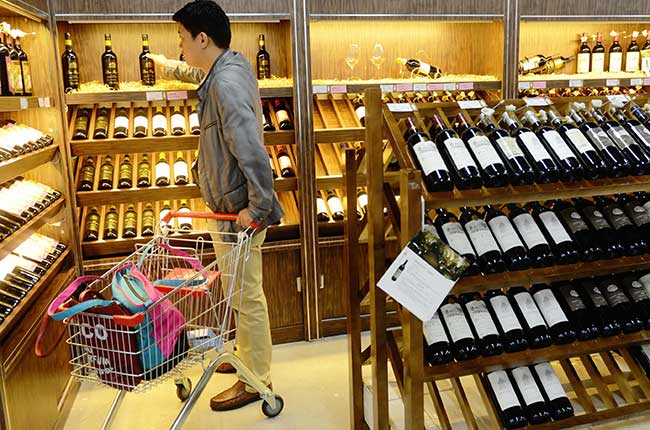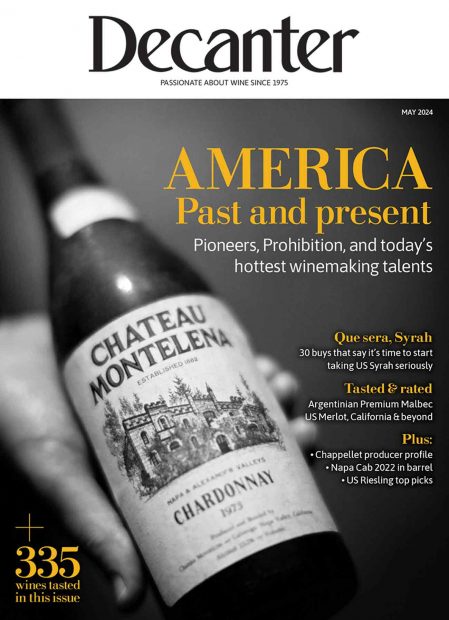Will China one day overtake the USA to become the world’s leading wine-drinking nation? Andrew Jefford explores wine culture in China in his latest weekly column.
I think it’s inevitable — given that China’s population is more than four times larger than that of the USA; given that most Chinese drinkers regard wine as health-bringing; given that meals are a focal point of Chinese life and that the Chinese gastronomic tradition is unsurpassed; given that there are almost no religious proscriptions on alcohol in China; given that China’s tea culture makes the concept of terroir easy to understand; and given that China’s greatest poets celebrated the drinking of ‘wine’ to the point of intoxication well over a millennium ago, during the T’ang dynasty, and that getting mildly sozzled with your friends on almost any beautiful pretext has been a matter of cultural aspiration ever since.
The growth, admittedly, appears to have been on hold since December 4th 2012. On that day, the political bureau of the central committee of the Communist Party of China, under the chairmanship of Xi Jinping, drew up the ‘eight-point regulation’ which changed the tone of how the Party conducts itself in China, and thus laid down guidelines for what are acceptable norms in Chinese business life. Businessmen were thenceforth expected to cease courting both tigers and flies (lofty and lowly corrupt officials) with Lafite and Lafite-alikes. Wine-gifting was over. The perfect deal-lubricant became a career-blemishing gaffe overnight.
The market in fine Bordeaux has been tanking ever since, and stories are rife of overflowing Chinese warehouses full of hastily imported and now unwanted, badly stored and ever-more deeply distressed stock. One of the best-selling internet-retailed wines over the last year in China has been a Marlborough Sauvignon Blanc. Vintage? 2009. Yum.
Optimism, though, is slowly returning, and the Chinese wine market has now moved on from its initial anti-corruption shock. “The last two years have been difficult,” said Maxime Lu, the founder and chief editor of wineonline.cn, “and plenty of importers went bankrupt. The focus used to be on group consumption and official consumption, but now it’s totally changed to the individual consumer. That’s much more healthy.” Marcus Ford of Shanghai-based importer and retailer Pudao Wines agrees. “Three or four years ago, the majority of wine-purchasing decisions weren’t made by the person who was going to drink the wine. Nowadays, the majority of purchasing decisions are made by the person who is going to drink the wine. That’s a big shift.” In other words, the Chinese wine-market is becoming more like other markets.
Those involved in wine education report a burgeoning interest, too. Dorian Tang has been involved in delivering WSET education to students all over China via ASC Fine Wines since 1996. “To begin with, there were hardly any consumers coming to classes; it was mostly trade people and foreigners. Now, it’s doctors, teachers – real wine lovers who don’t necessarily want to be certified or take the exam, but who just want to learn about wine in a very systematic way.” The dramatic expansion of China’s middle class predicted by, among others, Apple CEO Tim Cook seems likely to fuel this interest.
The former hegemony of Bordeaux is finished. “Five years ago, it was all Bordeaux,” says fluent Mandarin-speaker and long-term Chinese wine consultant Julien Boulard. “Now it’s much more fragmented. And there’s definitely a lot more Australian wine.” Wines from Chile and New Zealand, moreover, have benefited from zero import tax rates negotiated by their governments (though they are still subject to consumption tax and VAT), with Australia scheduled to enjoy the same privilege in a couple of years. The practical difference is that Chilean and New Zealand wines are levied 27 per cent tax on top of the import price, whereas wine from other countries is levied 48 per cent. “This new diversity,” adds Marcus Ford, “is a good way of combating fraud. In a diverse market, the fakers aren’t sure what to fake any more.” It’s also become harder to smuggle wine into China without paying any tax on it. (Three years ago, up to half the fine wine in China was said to have been smuggled over the border.)
For further views on how the top-end of wine sales has evolved, I spoke to Jo Purcell, who set up Farr Vintners’ Hong Kong office in 1997 and has run it ever since. She says the interest from China is still strong, though Chinese collectors tend to purchase more often through Hong Kong subsidiaries than formerly, in part because of foreign exchange caps recently imposed by Chinese banks. The confiscation of bottles from cases by China’s ‘hygiene inspectors’ for ‘testing’ remains a pernicious problem, though. Those buying six bottles of DRC La Tâche may only receive five, and a case of Lafite could mean 10 bottles: a bit of a bummer. However she feels that the much-publicised switch from Bordeaux to Burgundy may be ending. “The problem with Burgundy,” says Purcell, “is that everybody wants the same growers — Rousseau, Dugat-Py, Roumier, and there’s not a lot of supply, so the prices have gone up massively. But Bordeaux prices have come down. Top burgundy was attractive at £3,000 a case when the First Growths were £10,000 a case. Now the Bordeaux may have come down to £4,000 a case, whereas the Burgundy has gone up to £6,000 a case. We’re seeing a lot of people come back to the Bordeaux market because the mature vintages — and I stress the mature vintages — are at the right price.”
India is sometimes mentioned as a potential rival to China, but no one I spoke had much optimism about the future of imported wines there. “India,” as Jo Purcell put it, “takes taxation to another level altogether.” The national tax on imported wine (called Customs Duty) is around 160 per cent of the buying price, and then each state adds its own state taxes (called Excise), which vary greatly. In Delhi, for example, Excise is a further 65% of the wholesale price; the overall tax take on wine, thus, usually exceeds 200 per cent. There has been talk of eliminating Customs Duty, but if that was to happen, says author and consultant Magandeep Singh, then the states would gleefully up Excise rates in compensation: alcohol is their main source of revenue.
In both countries, of course, the main beneficiaries of any wine revolution will be domestic producers – over 80 per cent of the Chinese market is Chinese-grown (or at any rate blended) wine. But if you have almost 1.4 billion citizens, then a 17-per-cent imported wine share is still a hugely attractive prospect. Even without the need to toss titbits to the tigers and flies.





